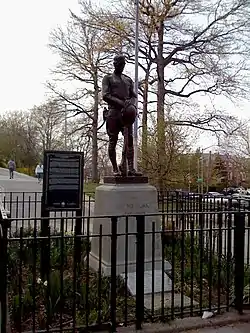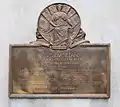Burt Johnson
Burt William Johnson (25 April 1890—27 March 1927)[1] was an American sculptor.

Biography
Johnson was born in Flint, Ohio. At the age of 13, he went to live for a year in Cornish, New Hampshire,[2] where his older sister Annetta Johnson Saint-Gaudens, wife of sculptor Louis St. Gaudens, was studying with Louis' brother, master sculptor Augustus St. Gaudens.[3] Johnson moved to Claremont, California in 1907 to study at Pomona College, and then to New York City in 1909 to study at the Art Students League of New York.[1][4] He worked with fellow sculptors James Earle Fraser, Robert I. Aitken and George Bridgman, as well as his brother-in-law, Louis St. Gaudens.[5] Back in California after Louis St. Gaudens' death in 1913, he moved into the studio that his brother-in-law had created during a visit to Claremont.[2]
Johnson remained active in both California and New York, and is well known for his statues honoring American soldiers of World War I, known as doughboys. Examples of these doughboy statues can be found in DeWitt Clinton Park[6] and Doughboy Park[7] in New York City, the latter being named the best war memorial of its kind by the American Federation of Artists in 1928.[7] Garfield Park in Pomona, California has another World War I tribute created by Johnson, dedicated in 1923, with an allegorical representation of Pomona, the Goddess of Fruit, beside a young man.[8] The Children's Tribute to the World War Heroes (1919) in Robert Keller Park in Huntington Park, California, depicts a barefoot girl holding the uniform caps of a sailor and a doughboy to her heart.[9]
Among his earlier works is The Spirit of Spanish Music, a fountain with the bronze figure of a boy playing a flute, located in Lebus Court of the Mabel Shaw Bridges Hall of Music at Pomona College.[10][11] His allegorical figures of Architecture and Sculpture decorate the exterior of the 1927 Fine Arts Building (Los Angeles), with additional reliefs near the top of the building's façade. The inside lobby has a fountain with sculptures of children, modeled by his daughter, Cynthia (age 3) and his son Harvey (age 5).[12] That son, Harvey W. Johnson (1921-2005), was a prominent Western artist and became President of the Cowboy Artists of America.[13][14] In addition, Johnson's grandsons Casey Schwarz and Scott Lee Johnson continue the family involvement in sculpture. There is also a granddaughter, Darcy Lynn a painter, and a great granddaughter, Tamsin Parker, a painter and animator.
In 1918, Johnson was a leading candidate to execute a memorial to community leader and publisher of the Los Angeles Times, Gen. Harrison Gray Otis,. who had died the year before. The Los Angeles Evening Herald called him a "100 per cent American sculptor", and pictured him "putting the finishing touches" on his model for the memorial in a story announcing that the project would be delayed until after the conclusion of the World War, since the amount of bronze needed to complete the work "would be sufficient to construct two cannon".[15] The project ultimately was awarded to Russian sculptor Prince Paul Troubetzkoy[16]
For his final project, the façade and lobby sculptures of the Los Angeles Fine Arts Building, Johnson's sister, Annetta Johnson Saint-Gaudens, and her son Paul St Gaudens, both sculptors themselves, provided assistance,[17] as did Santa Monica, California sculptor Merrell Gage.[2] In his final years, feeling he wanted to work on something creative and not concentrate just on sculpture, Johnson wrote a novel about an artist's life in Greenwich Village, New York City.[18] Burt Johnson died in Claremont, California on 27 March 1927 at the age of 36. He is buried next to his wife Ottilie M. Johnson (1891-1980) in Oak Park Cemetery, Claremont, California, USA.
Selected works (locations known)
- The Spirit of Spanish Music (1916) Pomona College, Claremont, California, USA
- Albert John Cook memorial tablet (1917) Pomona College Museum of Art
- Greek Theater commemorative tablet (dedicated 1917) Pomona College Museum of Art
- Children's Tribute to the World War Heroes (1919) Robert Keller Park, Huntington Park, California, USA
- Elisha Newton Dimick Memorial (1921) Palm Beach, Florida, USA
- World War Memorial Panel East Main Street and Hawthorne Avenue, College Park, Atlanta, Georgia, USA[18]
- Portrait bust (c.1921) of Dr Henry Kingman (1864-1921), early pastor Congregational Church, Claremont, California, USA[2]
- Theodore Edwin Norton Memorial Fountain and Tablet (1922) Pomona College, Claremont, California, USA
- Anna I. Young Memorial Panel (1923) Anna I. Young Alumnae House, Agnes Scott College, Decatur, Georgia, USA[19]
- Pomona World War I Memorial[20] (Goddess of Fruit) (1923) Garfield Park, Pomona, California, USA
- Doughboy Monument (1923) Doughboy Plaza, Queens (Woodside), New York, USA
- The Returned Soldier (1923) Lancaster Avenue and Locust Street, Columbia, Pennsylvania, USA
- Lobby and façade sculptures (1926) Fine Arts Building, Los Angeles, California, USA
- Flanders Field Doughboy (1927, dedicated 1930) De Witt Clinton Park, New York City
Selected works (current locations unknown)
- The Little Director[18] (1916) Mr and Mrs A.S. Bridges family garden, San Diego, California, USA
- Hope Braithwaite Smith memorial tablet (1917) Hope Braithwaite Smith Memorial Reading Room, Library (demolished), Pomona College, Claremont, California, USA
- Christ Panel[2] (April 1917) St Francis Hospital, La Crosse, Wisconsin
- Piping Faun, sculpture in front of the organ screen, right side of the proscenium, in Grauman's "Million Dollar" Theatre (1918) Los Angeles, California, USA
- The Answering Note Garden of Wm. G. Mather, Esq., Pasadena, California, USA[18][21]
- Little Sculptor Boy,[19] at one time in Lobby of the Fine Arts Building, Los Angeles, California (c.1927)
Gallery
 Statue at Doughboy Park in Woodside, Queens
Statue at Doughboy Park in Woodside, Queens DeWitt Clinton Park in Manhattan also has a doughboy statue
DeWitt Clinton Park in Manhattan also has a doughboy statue Goddess of Fruit World War I memorial in Garfield Park, Pomona, California
Goddess of Fruit World War I memorial in Garfield Park, Pomona, California The Spirit of Spanish Music (aka Pastoral Flutist) was commissioned by the Pomona College Class of 1915, installed in 1916 and restored in 2015
The Spirit of Spanish Music (aka Pastoral Flutist) was commissioned by the Pomona College Class of 1915, installed in 1916 and restored in 2015 studio snapshot of Burt W. Johnson, working on his plaster model of The Spirit of Spanish Music (1916)
studio snapshot of Burt W. Johnson, working on his plaster model of The Spirit of Spanish Music (1916) studio snapshot of working model of The Little Director, sculpture for the San Diego (California) home of Mr and Mrs A.S. Bridges (1916)"
studio snapshot of working model of The Little Director, sculpture for the San Diego (California) home of Mr and Mrs A.S. Bridges (1916)" Johnson's studio in Claremont, California, with miniature of The Little Director at right of desk
Johnson's studio in Claremont, California, with miniature of The Little Director at right of desk Cook Memorial Tablet (1917), Pomona College Museum of Art, Claremont, California
Cook Memorial Tablet (1917), Pomona College Museum of Art, Claremont, California Christ Panel (April 1917), St Francis Hospital, La Crosse, Wisconsin
Christ Panel (April 1917), St Francis Hospital, La Crosse, Wisconsin Greek Theater Tablet (dedicated 1917), Pomona College Museum of Art, Claremont, California
Greek Theater Tablet (dedicated 1917), Pomona College Museum of Art, Claremont, California Children's Tribute to the World War Heroes (1919), Huntington Park, California
Children's Tribute to the World War Heroes (1919), Huntington Park, California World War I memorial plaque, College Park, Georgia (1921)
World War I memorial plaque, College Park, Georgia (1921) Portrait bust of Dr Henry Kingman (c.1921), United Church of Christ, Claremont, California, USA
Portrait bust of Dr Henry Kingman (c.1921), United Church of Christ, Claremont, California, USA Theodore Edwin Norton Memorial Fountain (1922, detail), Pomona College, Claremont, California
Theodore Edwin Norton Memorial Fountain (1922, detail), Pomona College, Claremont, California Memorial plaque for Anna I. Young (1923), Agnes Scott College, Decatur, Georgia, USA
Memorial plaque for Anna I. Young (1923), Agnes Scott College, Decatur, Georgia, USA Little Sculptor Boy, at one time in Lobby of Fine Arts Building, Los Angeles, California (c.1927)
Little Sculptor Boy, at one time in Lobby of Fine Arts Building, Los Angeles, California (c.1927) Fountain sculpture group in Lobby of The Fine Arts Building, Los Angeles
Fountain sculpture group in Lobby of The Fine Arts Building, Los Angeles Fountain sculptures, including The High Note (1926), Lobby of the Fine Arts Building, 7th Street, Los Angeles
Fountain sculptures, including The High Note (1926), Lobby of the Fine Arts Building, 7th Street, Los Angeles Architecture, façade sculpture at 4th floor, left side, of Fine Arts Building, Los Angeles
Architecture, façade sculpture at 4th floor, left side, of Fine Arts Building, Los Angeles Sculpture, façade sculpture at 4th floor, right side, of Fine Arts Building, Los Angeles
Sculpture, façade sculpture at 4th floor, right side, of Fine Arts Building, Los Angeles Façade bas-relief at top, left side, of Fine Arts Building, Los Angeles
Façade bas-relief at top, left side, of Fine Arts Building, Los Angeles Façade bas-relief at top, right side, of Fine Arts Building, Los Angeles
Façade bas-relief at top, right side, of Fine Arts Building, Los Angeles Façade sculptures at 10th floor, left and right side, of Fine Arts Building, Los Angeles
Façade sculptures at 10th floor, left and right side, of Fine Arts Building, Los Angeles
External links
| Wikimedia Commons has media related to Burt Johnson. |
- Claremont Colleges Digital Archive, 31 historic images
- Burt W. Johnson, 1890-1927 (Folder), Smithsonian Institution, CollectionsSearchCenter
References
- Moore, Nancy Dustin Wall. Dictionary of Art and Artists in Southern California Before 1930. Los Angeles: Privately printed, 1975, p.130
- Berryman, Florence Seville. "An American sculptor and his achievement". Daughters of the American Revolution Magazine, Volume LXII Number 2, November 1928, pp.661-667
- Hughes, Edan Milton. Artists in California 1786-1940. San Francisco: Hughes Publishing Company, 1986
- Arts and Decoration. Volume 6 Number 1, November 1915, p.6
- Fielding, Mantle. Dictionary of American Painters, Sculptors and Engravers, Enlarged Edition. Greens Farms CT: Modern Books and Crafts, 1926/1974, p.189
- Clinton War Memorial (Doughboy), De Witt Clinton Park, inaugurated 1930
- The Woodside Doughboy, Doughboy Park, Woodside, New York, inaugurated 1923
- Los Angeles Times, 14 May 1923, p.7 (photograph)
- Blackstock, Joe (17 June 2016). "Local sculptor gets his spot in the limelight again". Inland Valley Daily Bulletin. (photographs); based on a public lecture given by Dr. Priscilla Schwarz, lecturer in art history, Oklahoma State University, 28 May 2016, Pomona, California.
- "Lebus Court, Pomona College". arthistory.pomona.edu
- "1915 Pomona College timeline". www.pomona.edu/
- "The Fine Arts Building". publicartina.com
- CowboyArtistsofAmerica Harvey Johnson obituary
- About the Artist Archived 2013-11-11 at the Wayback Machine harveywjohnson.com official site
- "Delay statue of general to help win present war", Los Angeles Evening Herald, Number 149, 24 April 1918
- Wood, Helen B. "Los Angeles", American Art News, Volume XVII Number 21, 1 March 1919, p.3
- Cuba, Stan. The Denver Artists Guild: Its Founding Members; An Illustrated History. Denver: History Colorado, 2015
- Los Angeles Times, 29 March 1927, p.A4 (Burt Johnson obituary)
- American Art Annual, Volume XXIV, 1926, p.342 (Burt Johnson obituary)
- Blackstock, Joe (11 January 2016). "Key historical sites locally may get their due in 2016". Inland Valley Daily Bulletin. (photographs)
- Index of Exhibits. New York: The Architectural League of New York, 1922, p.12